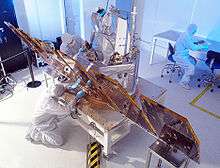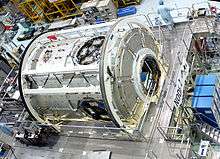Aerospace manufacturer
.jpg)


An aerospace manufacturer is a company or individual involved in the various aspects of designing, building, testing, selling, and maintaining aircraft, aircraft parts, missiles, rockets, or spacecraft. Aerospace is a high technology industry.
In 2015 the Aircraft Production was worth $180.3 Billion: 61% airliners, 14% business and general aviation, 12% Military aircraft, 10% military rotary wing and 3% civil rotary wing; while their MRO was worth $135.1 Bn or $315.4 Bn combined.[1]
Largest Companies
| Company | Revenue | Profit |
|---|---|---|
| Boeing | $90.8 billion (+4.8%) | $7.47 billion (+13.9%) |
| Airbus | $80.6 billion (+5.5%) | $4.50 billion (+31.9%) |
| Lockheed Martin | $45.6 billion (+0.5%) | $5.59 billion (+24.1%) |
| United Technologies | $36.2 billion (+6.1%) | $4.57 billion (+1.9%) |
| GE Aviation | $24.0 billion (+9.1%) | $5.0 billion (+15.0%) |
| Northrop Grumman | $24.0 billion (-2.8%) | $3.20 billion (+2.3%) |
| Raytheon | $22.8 billion (-3.7%) | $3.18 billion (+8.2%) |
| Safran | $18.3 billion (+7.3%) | $2.74 billion (+14.4%) |
| Finmeccanica | $17.2 billion (+6.1%) | $0.715 billion |
| Rolls-Royce Holdings | $14.7 billion (-3.7%) | $2.15 billion (+2.0%) |
Geography
In the European Union, aerospace companies such as Airbus, BAE Systems, Thales, Dassault, Saab AB, Terma A/S and Leonardo are participants in the global aerospace industry and research effort.
In Russia, large aerospace companies like Oboronprom and the United Aircraft Corporation (encompassing Mikoyan, Sukhoi, Ilyushin, Tupolev, Yakovlev, and Irkut, which includes Beriev) are among the major global players in this industry.
In the United States, the Department of Defense and NASA are the two biggest consumers of aerospace technology and products. The Bureau of Labor Statistics of the United States reported that the aerospace industry employed 444,000 wage and salary jobs in 2004, many of which were in Washington and California, this marked a steep decline from the peak years during the Reagan Administration when total employment exceeded 1,000,000 aerospace industry workers.[3]
During that period of recovery a special program to restore U.S. competitiveness across all U.S. industries, Project Socrates, contributed to employment growth as the U.S. aerospace industry captured 72 percent of world aerospace market. By 1999 U.S. share of the world market fell to 52 percent.
Cities
Important locations of the civil aerospace industry worldwide include Seattle, Wichita, Kansas, Dayton, Ohio and St. Louis in the United States (Boeing), Montreal and Toronto in Canada (Bombardier, Pratt & Whitney Canada), Toulouse in France and Hamburg in Germany (Airbus, EADS), the North-West of England and Bristol in Britain (BAE Systems, Airbus and AgustaWestland), Komsomolsk-on-Amur and Irkutsk in Russia (Sukhoi, Beriev), Kiev and Kharkiv in Ukraine (Antonov), Nagoya in Japan (Mitsubishi Heavy Industries Aerospace and Kawasaki Heavy Industries Aerospace), as well as São José dos Campos in Brazil where Embraer is based.
Consolidation
Several consolidations took place in the aerospace and defense industries over the last few decades. Between 1988 and 2010, more than 5,452 mergers & acquisitions with a total known-value of US$579 billion were announced worldwide.[4]
The largest transactions include the merger of Boeing with McDonnell Douglas valued at US$13.3 billion in 1996.[5] Marconi Electronic Systems, a subsidiary of the General Electric Company plc, was acquired by British Aerospace for US$12.3 billion in 1999 merger,[6] to forme BAE Systems. Raytheon acquired Hughes Aircraft Company for $9.5 billion in 1997.[7]
Suppliers
The largest aerospace suppliers are United Technologies with $28.2 Billion of revenue, followed by GE Aviation with $24.7 Billion, Safran with $22.5 Billion, Rolls-Royce Holdings with $16.9 Billion, Honeywell Aerospace with $15.2 Billion and Rockwell Collins including B/E Aerospace with $8.1 Billion.[8]
Supply chain
Before the 1980s/1990s, aircraft and aeroengine manufacturers were vertically integrated. Then Douglas aircraft outsourced large aerostructures and the Bombardier Global Express pioneered the “Tier 1” supply chain model inspired by automotive industry, with 10-12 risk-sharing limited partnerss funding around half of the development costs. The Embraer E-Jet followed in the late 1990s with fewer than 40 primary suppliers. Tier 1 suppliers were led by Honeywell, Safran, Goodrich Corporation and Hamilton Sundstrand.[9]
In the 2000s Rolls-Royce reduced its supplier count after bringing in automotive supply chain executives. On the Airbus A380, less than 100 major suppliers outsource 60% of its value, even 80% on the A350XWB. Boeing embraced an aggressive Tier 1 model for the B787 but with its difficulties began to question why it was earning lower margins than its suppliers while it seemed to take all the risk, ensuing its 2011 Partnering for Success initiative, as Airbus initiated its own Scope+ initiative for the A320. Tier 1 consolidation also affects engine manufacturers : GE Aviation acquired Avio in 2013 and Rolls-Royce plc is taking control of Industria de Turbo Propulsores.[9]
See also
- Aerospace
- Aviation accidents and incidents
- List of aircraft manufacturers
- List of spacecraft manufacturers
References
- ↑ Kevin Michaels (April 28, 2016). "MRO Industry Outlook" (PDF). ICF International.
- ↑ "Top 100 Aerospace Companies" (PDF). Flight International. 15–21 September 2015.
- ↑ Parker, Dana T. Building Victory: Aircraft Manufacturing in the Los Angeles Area in World War II, pp. 131-2, Cypress, CA, 2013.
- ↑ "Mergers & Acquisitions - Aerospace & Defense". Thomson Financial, Institute for Mergers, Acquisitions and Alliances.
- ↑ "Boeing offering $13 billion to buy McDonnell Douglas". New York Times. Dec 16, 1996.
- ↑ "All-UK merger sends European defence into disarray". Flight International. 27 January 1999.
- ↑ "Raytheon wins bidding war for Hughes Aircraft". Flight International. 22 January 1997.
- ↑ Thierry Dubois and Jens Flottau (Jan 20, 2017). "Tier 1 Consolidation Continues As Safran Takes Over Zodiac". Aviation Week & Space Technology.
- 1 2 Kevin Michaels (May 18, 2017). "Beware, OEM-supplier Relations Are Changing". Aviation Week & Space Technology.
Further reading
- Hartley, Keith. The Political Economy Of Aerospace Industries: A Key Driver of Growth and International Competitiveness? (Edward Elgar, 2014); 288 pages; the industry in Britain, continental Europe, and the US with a case study of BAE Systems.
- Newhouse, John. The Sporty Game: The High-Risk Competitive Business of Making and Selling Commercial Airliners. New York: Alfred A. Knopf, 1982. ISBN 978-0-394-51447-5.
External links
- "U.S. Aerospace Industries Association".
- "Aerospace, Defense & Government Services – Mergers & Acquisitions (January 1993 - December 2016)" (PDF). Grundman Advisory. 6 Apr 2017.